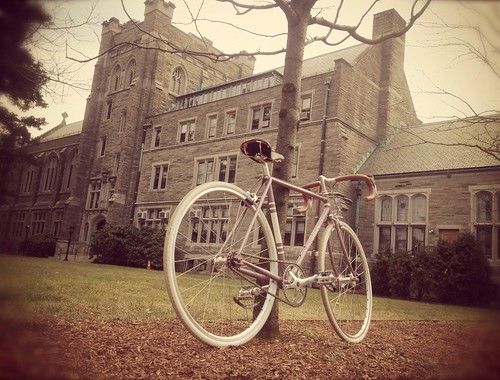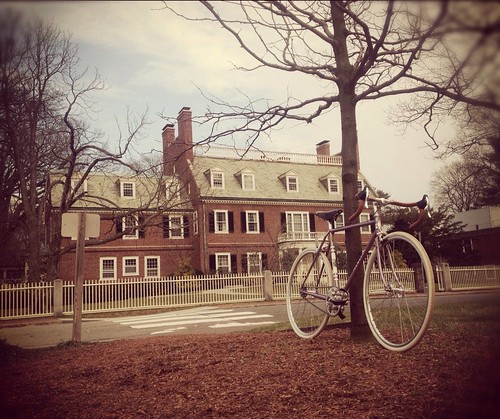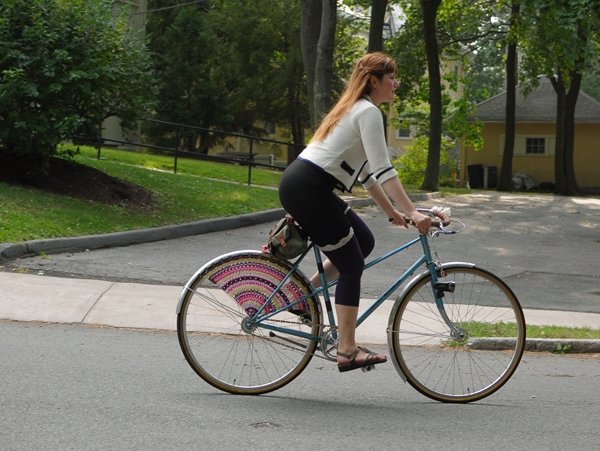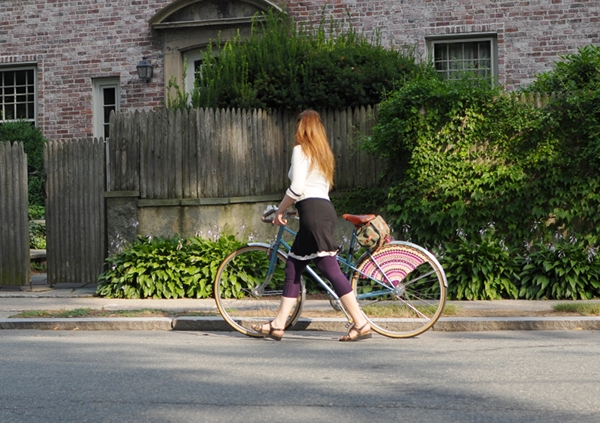
I have been riding fixed gear bicycles for about a year and a half now, and enjoy it so much that it is hard to talk about without getting embarrassed. Here in the Boston area, fixed gear is associated with a distinct cultural attitude and fashion sense, and I do not fit the mold. Seeing me on a bicycle with a fixed drivetrain often seems to surprise people, and I've been told on more than one occasion that I "don't seem like the type." While I suspect this is mostly used as a conversation starter by men, it still succeeds in making me self-conscious. What is it about fixed gear that I like so much and why do I "need" this type of bicycle?

I first tried a fixed gear bike in June . I was staying in Vienna and pining over the nearby velodrome's summer closure, and a friend offered to teach me to ride a track bike so that I could ride
around the velodrome building (this seemed very funny at the time - around the velodrome, get it?). I was afraid to try it at first, but as soon as I got on the bike I didn't want to get off it. It felt so natural and intuitive. My friend ended up leaving the bicycle with me for the duration of my stay in Vienna and I rode it in the park after work every chance I got. Cycling slowly due to the lack of brakes, I must have looked like an idiot, but didn't care. I discovered that on fixed gear, my bicycle handling skills somehow improved. I could make tighter turns, cycle through narrow spaces, control my speed better, and just be more in control. It felt as if I suddenly gained a better understanding of how a bicycle worked. The custom Italian track bike made for a now-retired racer felt unexpectedly comfortable, save for the curvature of the handlebars. I could ride this thing for hours with a silly smile on my face. It became clear during those rides that I needed a fixed gear bike of my own once I returned to the US. A friend of a friend sold me a good road frame for fixed gear conversion, and I mailed it to myself in Boston before leaving Vienna.

Waiting for the road frame to arrive (it took over 3 weeks!) I couldn't stop talking about my experience with fixed gear, and just for the heck of it one weekend the Co-Habitant and I converted the
Motobecane mixte I then owned to a single speed with a fixed/free flip-flop hub. Doing this was easy and inexpensive. We picked up a budget wheelset, modified the existing crankset, shortened the chain and that was pretty much that. I rode this bicycle around the city and out to the countryside, and it was great fun. But I mostly thought of it as a novelty. On an upright bike, I preferred a freewheel. This bicycle was a great hit around the neighbourhood though, especially when I fitted it with some colourful dressguards. The woman who later bought it planned to use it as a freewheel single speed, but liked the idea of having the fixed option by flipping the wheel.

Finally the vintage road frame I'd bought in Vienna arrived in the mail, and we quickly put it together. You might recognise this as the previous incarnation of theMoser I now ride as a geared roadbike. The tires here look huge, but they are 28mm
Panaracer Paselas - the frame had just enough clearance for them if I did not use a rear brake. I rode this bike a lot, and particularly enjoyed it once it began to get cold. There was something about cold and dreary days on a fixed gear that was just magic.But while I loved riding the
Moser, it became apparent over time that the frame was not really suitable for fixed gear conversion due to its very low bottom bracket. As my speed on the bike increased I started to get pedal strike when cornering on bumpy or uneven roads, and did not feel that this was safe. Last winter I began to look for another frame, which did not prove to be very easy given my criteria (lugged steel, horizontal dropouts, high bottom bracket, small size,and no toe overlap). I considered getting a frame from
Royal H., but could not afford it. I considered the new SimpleOne from
Rivendell, but learned that they would not be making one in my size. And that is how I came to be in possession of a Mercian.

By the time I ordered this bicycle from
Mercian, I had a good idea of what I wanted in a fixed gear. I did not want a track bike, but a comfortable and somewhat relaxed roadbike that just happened to have afixed gear drivetrain. I wanted to fit it with 28mm-32mm tires for road and occasional trails. I wanted it to have tame handling without feeling sluggish. All of this was done. When I began to ride this bicycle after we put it together, it was just the feeling I wanted. It is comfortable, intuitive, has no toe overlap or pedal strike, and I can ride it for quite a long time without getting tired.
So why fixed gear and what do I like about it so much? If I have to pin it down, there are two distinct elements of this type of bike that I enjoy. First, I simply find it soothing and pleasant. The motions my legs make on a fixed gear feel different - more circular and rhythmical.In that sense it is really not about speed at all, but about being able to ride with smooth and regular pedal strokes and enjoying the state of mind this puts me in. I find this to be very relaxing when I am stressed out. Even just riding in circles around the neighbourhood, the magical sensation of the drivetrain never fails to calm me down and clear my head.

Second, I feel that riding a fixed gear roadbike helps me with technique. My movements feel more elegant and precise, and I can sense that I am developing a more intuitive sense of balance. I play games where I try to keep the bike going at all costs - slowing down to a crawl before a traffic light rather than stop as I wait for it to turn green. I also like to see how fast I can accelerate under different circumstances, and play "sprinting" games until I get out of breath. This is much more interesting to do on a fixed gear than on a freewheel bike, because once you get the drivetrain going it feels as if it "helps" you. All this may sound silly, but somehow I feel that things like this really help. Fixed gear bikes feel playful and very safe, which encourages me to try all this stuff that I would not normally try. Slowly but surely, I can tell that it improves my geared roadcycling skills - including the somewhat "duh" realisation that if I continuously pedal and feather the brakes instead of coasting, then I will feel more in control of my geared roadbike as well.
But all this talk of technique is probably beside the point. When it comes down to it, we do things that we enjoy and fixed gear is for me simply one of those things. I can't imagine not owning a bike like this. I begin to get fixed gear cravings if I don't ride one for more than a week. Luckily, that should not be a problem.
 Sometimes I get emails where ladies send me pictures of their bicycle and ask whether I think "it would look better" with dress guards and/or a chaincase. Ladies... You do realise that these things are not there for the looks, right? Although a set of dress guards and a chaincasedo lend a certain charm to a bicycle, aesthetics are not their primary purpose. So let me explain why I put them on my bikes, and then you can decide for yourself whether you need them or not.
Sometimes I get emails where ladies send me pictures of their bicycle and ask whether I think "it would look better" with dress guards and/or a chaincase. Ladies... You do realise that these things are not there for the looks, right? Although a set of dress guards and a chaincasedo lend a certain charm to a bicycle, aesthetics are not their primary purpose. So let me explain why I put them on my bikes, and then you can decide for yourself whether you need them or not. The purpose of dress guards is to stop fluttery, loose clothing from flying into the spokes of your rear wheel and either getting ruined or causing an accident.The main determinant of whether you need dressguards is whether you wearthe sort of clothing that requires their protection - for instance: flared skirts, dresses, long coats, or flowing tunics. Once you have had something get stuck in your rear spokes or have seen it happen to someone else, you know that the possibility is real and that it can even cause injury. Personally,I will not ride a bicycle without dress guards if an article of clothing I am wearing is long enough to reach the rear spokes. And since much of my everyday clothing is in that category, it is a good idea for me to install dress guards on any bike I plan to use for transportation.
The purpose of dress guards is to stop fluttery, loose clothing from flying into the spokes of your rear wheel and either getting ruined or causing an accident.The main determinant of whether you need dressguards is whether you wearthe sort of clothing that requires their protection - for instance: flared skirts, dresses, long coats, or flowing tunics. Once you have had something get stuck in your rear spokes or have seen it happen to someone else, you know that the possibility is real and that it can even cause injury. Personally,I will not ride a bicycle without dress guards if an article of clothing I am wearing is long enough to reach the rear spokes. And since much of my everyday clothing is in that category, it is a good idea for me to install dress guards on any bike I plan to use for transportation. I have also been asked what kind of dressguards are better: netted or solid. There are probably differing opinions on this, but in my experience it does not matter. My vintage Raleigh(above) is fitted with very minimal dressguards that are basically just stretchy cords fanning out from the rear dropouts. For me, this has been sufficient; the cords - closely spaced - provide a perfectly functional barrier.The obvious advantage to dress guards that are woven, is that they are lighter (and usually more attractive) than plastic ones. The disadvantage is that they can be more expensive and more difficult to clean.
I have also been asked what kind of dressguards are better: netted or solid. There are probably differing opinions on this, but in my experience it does not matter. My vintage Raleigh(above) is fitted with very minimal dressguards that are basically just stretchy cords fanning out from the rear dropouts. For me, this has been sufficient; the cords - closely spaced - provide a perfectly functional barrier.The obvious advantage to dress guards that are woven, is that they are lighter (and usually more attractive) than plastic ones. The disadvantage is that they can be more expensive and more difficult to clean. Moving on to chaincases, their purpose is two-fold: (1) to prevent the bottoms of your trousers from being caught in the chain, and (2) to keep the chain clean from street grime, especially in bad weather. Since I seldom wear long trousers, the first function is not that important to me. So while I do appreciate that the chaincase keeps my chain nice and clean, this accessory is not as crucial for me as dress guards, because it is a maintenance feature rather than a safety feature. I can still ride a bike without a chaincase for transportation.
Moving on to chaincases, their purpose is two-fold: (1) to prevent the bottoms of your trousers from being caught in the chain, and (2) to keep the chain clean from street grime, especially in bad weather. Since I seldom wear long trousers, the first function is not that important to me. So while I do appreciate that the chaincase keeps my chain nice and clean, this accessory is not as crucial for me as dress guards, because it is a maintenance feature rather than a safety feature. I can still ride a bike without a chaincase for transportation. Furthermore, while I have found dress guards to be effective in preventing clothing from getting stuck in the spokes, I have not found chaincases to be entirely effective on those rare occasions when I do wear trousers. A couple of times, the bottoms of my trousers have actually gotten stuck on the chaincase itself, which has only increased my bias for skirts once I started cycling. Don't get me wrong, I still love a nice, elegant chaincase. But I admit that this feature does not hold as much functional purpose for me as do dress guards.
Furthermore, while I have found dress guards to be effective in preventing clothing from getting stuck in the spokes, I have not found chaincases to be entirely effective on those rare occasions when I do wear trousers. A couple of times, the bottoms of my trousers have actually gotten stuck on the chaincase itself, which has only increased my bias for skirts once I started cycling. Don't get me wrong, I still love a nice, elegant chaincase. But I admit that this feature does not hold as much functional purpose for me as do dress guards. Dress guards and chaincases are not affectations, but necessary accessories for transportation in everyday clothing. As the popularity of "city bikes" rises, I hope that more American bicycle shops will realise this, and start carrying these useful items.
Dress guards and chaincases are not affectations, but necessary accessories for transportation in everyday clothing. As the popularity of "city bikes" rises, I hope that more American bicycle shops will realise this, and start carrying these useful items.
 I have been riding fixed gear bicycles for about a year and a half now, and enjoy it so much that it is hard to talk about without getting embarrassed. Here in the Boston area, fixed gear is associated with a distinct cultural attitude and fashion sense, and I do not fit the mold. Seeing me on a bicycle with a fixed drivetrain often seems to surprise people, and I've been told on more than one occasion that I "don't seem like the type." While I suspect this is mostly used as a conversation starter by men, it still succeeds in making me self-conscious. What is it about fixed gear that I like so much and why do I "need" this type of bicycle?
I have been riding fixed gear bicycles for about a year and a half now, and enjoy it so much that it is hard to talk about without getting embarrassed. Here in the Boston area, fixed gear is associated with a distinct cultural attitude and fashion sense, and I do not fit the mold. Seeing me on a bicycle with a fixed drivetrain often seems to surprise people, and I've been told on more than one occasion that I "don't seem like the type." While I suspect this is mostly used as a conversation starter by men, it still succeeds in making me self-conscious. What is it about fixed gear that I like so much and why do I "need" this type of bicycle? I first tried a fixed gear bike in June . I was staying in Vienna and pining over the nearby velodrome's summer closure, and a friend offered to teach me to ride a track bike so that I could ride around the velodrome building (this seemed very funny at the time - around the velodrome, get it?). I was afraid to try it at first, but as soon as I got on the bike I didn't want to get off it. It felt so natural and intuitive. My friend ended up leaving the bicycle with me for the duration of my stay in Vienna and I rode it in the park after work every chance I got. Cycling slowly due to the lack of brakes, I must have looked like an idiot, but didn't care. I discovered that on fixed gear, my bicycle handling skills somehow improved. I could make tighter turns, cycle through narrow spaces, control my speed better, and just be more in control. It felt as if I suddenly gained a better understanding of how a bicycle worked. The custom Italian track bike made for a now-retired racer felt unexpectedly comfortable, save for the curvature of the handlebars. I could ride this thing for hours with a silly smile on my face. It became clear during those rides that I needed a fixed gear bike of my own once I returned to the US. A friend of a friend sold me a good road frame for fixed gear conversion, and I mailed it to myself in Boston before leaving Vienna.
I first tried a fixed gear bike in June . I was staying in Vienna and pining over the nearby velodrome's summer closure, and a friend offered to teach me to ride a track bike so that I could ride around the velodrome building (this seemed very funny at the time - around the velodrome, get it?). I was afraid to try it at first, but as soon as I got on the bike I didn't want to get off it. It felt so natural and intuitive. My friend ended up leaving the bicycle with me for the duration of my stay in Vienna and I rode it in the park after work every chance I got. Cycling slowly due to the lack of brakes, I must have looked like an idiot, but didn't care. I discovered that on fixed gear, my bicycle handling skills somehow improved. I could make tighter turns, cycle through narrow spaces, control my speed better, and just be more in control. It felt as if I suddenly gained a better understanding of how a bicycle worked. The custom Italian track bike made for a now-retired racer felt unexpectedly comfortable, save for the curvature of the handlebars. I could ride this thing for hours with a silly smile on my face. It became clear during those rides that I needed a fixed gear bike of my own once I returned to the US. A friend of a friend sold me a good road frame for fixed gear conversion, and I mailed it to myself in Boston before leaving Vienna. Waiting for the road frame to arrive (it took over 3 weeks!) I couldn't stop talking about my experience with fixed gear, and just for the heck of it one weekend the Co-Habitant and I converted the Motobecane mixte I then owned to a single speed with a fixed/free flip-flop hub. Doing this was easy and inexpensive. We picked up a budget wheelset, modified the existing crankset, shortened the chain and that was pretty much that. I rode this bicycle around the city and out to the countryside, and it was great fun. But I mostly thought of it as a novelty. On an upright bike, I preferred a freewheel. This bicycle was a great hit around the neighbourhood though, especially when I fitted it with some colourful dressguards. The woman who later bought it planned to use it as a freewheel single speed, but liked the idea of having the fixed option by flipping the wheel.
Waiting for the road frame to arrive (it took over 3 weeks!) I couldn't stop talking about my experience with fixed gear, and just for the heck of it one weekend the Co-Habitant and I converted the Motobecane mixte I then owned to a single speed with a fixed/free flip-flop hub. Doing this was easy and inexpensive. We picked up a budget wheelset, modified the existing crankset, shortened the chain and that was pretty much that. I rode this bicycle around the city and out to the countryside, and it was great fun. But I mostly thought of it as a novelty. On an upright bike, I preferred a freewheel. This bicycle was a great hit around the neighbourhood though, especially when I fitted it with some colourful dressguards. The woman who later bought it planned to use it as a freewheel single speed, but liked the idea of having the fixed option by flipping the wheel. Finally the vintage road frame I'd bought in Vienna arrived in the mail, and we quickly put it together. You might recognise this as the previous incarnation of theMoser I now ride as a geared roadbike. The tires here look huge, but they are 28mm Panaracer Paselas - the frame had just enough clearance for them if I did not use a rear brake. I rode this bike a lot, and particularly enjoyed it once it began to get cold. There was something about cold and dreary days on a fixed gear that was just magic.But while I loved riding the Moser, it became apparent over time that the frame was not really suitable for fixed gear conversion due to its very low bottom bracket. As my speed on the bike increased I started to get pedal strike when cornering on bumpy or uneven roads, and did not feel that this was safe. Last winter I began to look for another frame, which did not prove to be very easy given my criteria (lugged steel, horizontal dropouts, high bottom bracket, small size,and no toe overlap). I considered getting a frame from Royal H., but could not afford it. I considered the new SimpleOne from Rivendell, but learned that they would not be making one in my size. And that is how I came to be in possession of a Mercian.
Finally the vintage road frame I'd bought in Vienna arrived in the mail, and we quickly put it together. You might recognise this as the previous incarnation of theMoser I now ride as a geared roadbike. The tires here look huge, but they are 28mm Panaracer Paselas - the frame had just enough clearance for them if I did not use a rear brake. I rode this bike a lot, and particularly enjoyed it once it began to get cold. There was something about cold and dreary days on a fixed gear that was just magic.But while I loved riding the Moser, it became apparent over time that the frame was not really suitable for fixed gear conversion due to its very low bottom bracket. As my speed on the bike increased I started to get pedal strike when cornering on bumpy or uneven roads, and did not feel that this was safe. Last winter I began to look for another frame, which did not prove to be very easy given my criteria (lugged steel, horizontal dropouts, high bottom bracket, small size,and no toe overlap). I considered getting a frame from Royal H., but could not afford it. I considered the new SimpleOne from Rivendell, but learned that they would not be making one in my size. And that is how I came to be in possession of a Mercian. By the time I ordered this bicycle from Mercian, I had a good idea of what I wanted in a fixed gear. I did not want a track bike, but a comfortable and somewhat relaxed roadbike that just happened to have afixed gear drivetrain. I wanted to fit it with 28mm-32mm tires for road and occasional trails. I wanted it to have tame handling without feeling sluggish. All of this was done. When I began to ride this bicycle after we put it together, it was just the feeling I wanted. It is comfortable, intuitive, has no toe overlap or pedal strike, and I can ride it for quite a long time without getting tired.
By the time I ordered this bicycle from Mercian, I had a good idea of what I wanted in a fixed gear. I did not want a track bike, but a comfortable and somewhat relaxed roadbike that just happened to have afixed gear drivetrain. I wanted to fit it with 28mm-32mm tires for road and occasional trails. I wanted it to have tame handling without feeling sluggish. All of this was done. When I began to ride this bicycle after we put it together, it was just the feeling I wanted. It is comfortable, intuitive, has no toe overlap or pedal strike, and I can ride it for quite a long time without getting tired. Second, I feel that riding a fixed gear roadbike helps me with technique. My movements feel more elegant and precise, and I can sense that I am developing a more intuitive sense of balance. I play games where I try to keep the bike going at all costs - slowing down to a crawl before a traffic light rather than stop as I wait for it to turn green. I also like to see how fast I can accelerate under different circumstances, and play "sprinting" games until I get out of breath. This is much more interesting to do on a fixed gear than on a freewheel bike, because once you get the drivetrain going it feels as if it "helps" you. All this may sound silly, but somehow I feel that things like this really help. Fixed gear bikes feel playful and very safe, which encourages me to try all this stuff that I would not normally try. Slowly but surely, I can tell that it improves my geared roadcycling skills - including the somewhat "duh" realisation that if I continuously pedal and feather the brakes instead of coasting, then I will feel more in control of my geared roadbike as well.
Second, I feel that riding a fixed gear roadbike helps me with technique. My movements feel more elegant and precise, and I can sense that I am developing a more intuitive sense of balance. I play games where I try to keep the bike going at all costs - slowing down to a crawl before a traffic light rather than stop as I wait for it to turn green. I also like to see how fast I can accelerate under different circumstances, and play "sprinting" games until I get out of breath. This is much more interesting to do on a fixed gear than on a freewheel bike, because once you get the drivetrain going it feels as if it "helps" you. All this may sound silly, but somehow I feel that things like this really help. Fixed gear bikes feel playful and very safe, which encourages me to try all this stuff that I would not normally try. Slowly but surely, I can tell that it improves my geared roadcycling skills - including the somewhat "duh" realisation that if I continuously pedal and feather the brakes instead of coasting, then I will feel more in control of my geared roadbike as well.


 Funny that March should be the month to almost do us in, rather than January or February. But the key word is almost. My unexpected relationship with
Funny that March should be the month to almost do us in, rather than January or February. But the key word is almost. My unexpected relationship with 



